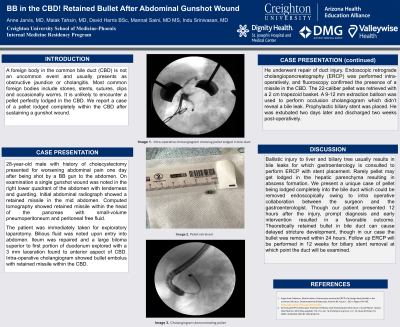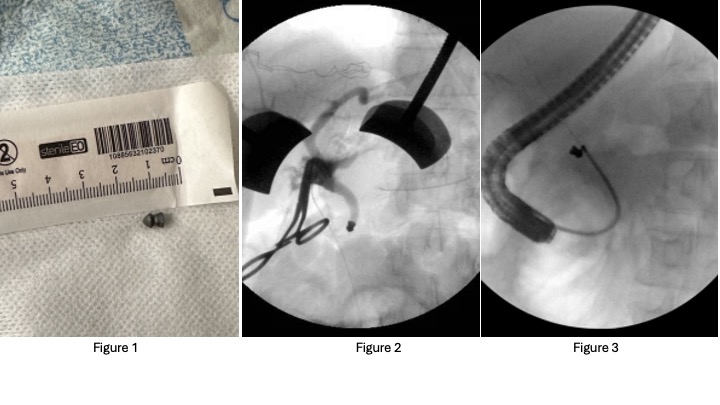Tuesday Poster Session
Category: Biliary/Pancreas
P3537 - BB in the CBD! Retained Bullet After Abdominal Gunshot Wound
Tuesday, October 29, 2024
10:30 AM - 4:00 PM ET
Location: Exhibit Hall E

.jpeg.jpg)
Anne Jarvis, MD
Creighton University School of Medicine
Phoenix, AZ
Presenting Author(s)
Anne Jarvis, MD1, Malak Tahsin, MD2, David K. Harris, BS1, Mannat Saini, MD, MS1, Indu Srinivasan, MD3
1Creighton University School of Medicine, Phoenix, AZ; 2Creighton University, Phoenix, AZ; 3Creighton University Medical Center, Phoenix, AZ
Introduction: A foreign body in the common bile duct (CBD) is not an uncommon event and usually presents as obstructive jaundice or cholangitis. Most common foreign bodies include stones, stents, sutures, clips and occasionally worms. It is unlikely to encounter a pellet perfectly lodged in the CBD. We report a case of a pellet lodged completely within the CBD after sustaining a gunshot wound.
Case Description/Methods: 28-year-old male with history of cholecystectomy presented for worsening abdominal pain one day after being shot by a BB gun to the abdomen. On examination a single gunshot wound was noted in the right lower quadrant of the abdomen with tenderness and guarding. Initial abdominal radiograph showed a retained missile in the mid abdomen. Computed tomography showed retained missile within the head of the pancreas with small-volume pneumoperitoneum and peritoneal free fluid.
The patient was immediately taken for exploratory laparotomy. Bilious fluid was noted upon entry into abdomen. Ileum was repaired and a large biloma superior to first portion of duodenum explored with a 3 mm laceration found to anterior aspect of CBD. Intra-operative cholangiogram showed bullet embolus with retained missile within the CBD. He underwent repair of duct injury. Endoscopic retrograde cholangiopancreatography (ERCP) was performed intra-operatively, and fluoroscopy confirmed the presence of a missile in the CBD. The 22-caliber pellet was retrieved with a 2 cm trapezoid basket. A 9-12 mm extraction balloon was used to perform occlusion cholangiogram which didn’t reveal a bile leak. Prophylactic biliary stent was placed. He was extubated two days later and discharged two weeks post-operatively.
Discussion: Ballistic injury to liver and biliary tree usually results in bile leaks for which gastroenterology is consulted to perform ERCP with stent placement. Rarely pellet may get lodged in the hepatic parenchyma resulting in abscess formation. We present a unique case of pellet being lodged completely into the bile duct which could be removed endoscopically owing to intra operative collaboration between the surgeon and the gastroenterologist. Though our patient presented 12 hours after the injury, prompt diagnosis and early intervention resulted in a favorable outcome. Theoretically retained bullet in bile duct can cause delayed stricture development, though in our case the bullet was removed within 24 hours. Follow up ERCP will be performed in 12 weeks for biliary stent removal at which point the duct will be examined.

Disclosures:
Anne Jarvis, MD1, Malak Tahsin, MD2, David K. Harris, BS1, Mannat Saini, MD, MS1, Indu Srinivasan, MD3. P3537 - BB in the CBD! Retained Bullet After Abdominal Gunshot Wound, ACG 2024 Annual Scientific Meeting Abstracts. Philadelphia, PA: American College of Gastroenterology.
1Creighton University School of Medicine, Phoenix, AZ; 2Creighton University, Phoenix, AZ; 3Creighton University Medical Center, Phoenix, AZ
Introduction: A foreign body in the common bile duct (CBD) is not an uncommon event and usually presents as obstructive jaundice or cholangitis. Most common foreign bodies include stones, stents, sutures, clips and occasionally worms. It is unlikely to encounter a pellet perfectly lodged in the CBD. We report a case of a pellet lodged completely within the CBD after sustaining a gunshot wound.
Case Description/Methods: 28-year-old male with history of cholecystectomy presented for worsening abdominal pain one day after being shot by a BB gun to the abdomen. On examination a single gunshot wound was noted in the right lower quadrant of the abdomen with tenderness and guarding. Initial abdominal radiograph showed a retained missile in the mid abdomen. Computed tomography showed retained missile within the head of the pancreas with small-volume pneumoperitoneum and peritoneal free fluid.
The patient was immediately taken for exploratory laparotomy. Bilious fluid was noted upon entry into abdomen. Ileum was repaired and a large biloma superior to first portion of duodenum explored with a 3 mm laceration found to anterior aspect of CBD. Intra-operative cholangiogram showed bullet embolus with retained missile within the CBD. He underwent repair of duct injury. Endoscopic retrograde cholangiopancreatography (ERCP) was performed intra-operatively, and fluoroscopy confirmed the presence of a missile in the CBD. The 22-caliber pellet was retrieved with a 2 cm trapezoid basket. A 9-12 mm extraction balloon was used to perform occlusion cholangiogram which didn’t reveal a bile leak. Prophylactic biliary stent was placed. He was extubated two days later and discharged two weeks post-operatively.
Discussion: Ballistic injury to liver and biliary tree usually results in bile leaks for which gastroenterology is consulted to perform ERCP with stent placement. Rarely pellet may get lodged in the hepatic parenchyma resulting in abscess formation. We present a unique case of pellet being lodged completely into the bile duct which could be removed endoscopically owing to intra operative collaboration between the surgeon and the gastroenterologist. Though our patient presented 12 hours after the injury, prompt diagnosis and early intervention resulted in a favorable outcome. Theoretically retained bullet in bile duct can cause delayed stricture development, though in our case the bullet was removed within 24 hours. Follow up ERCP will be performed in 12 weeks for biliary stent removal at which point the duct will be examined.

Figure: Figure 1. Pellet retrieved. Figure 2. Intra-operative cholangiogram showing pellet lodged in bile duct. Figure 3. Cholangiogram demonstrating pellet
Disclosures:
Anne Jarvis indicated no relevant financial relationships.
Malak Tahsin indicated no relevant financial relationships.
David Harris indicated no relevant financial relationships.
Mannat Saini indicated no relevant financial relationships.
Indu Srinivasan indicated no relevant financial relationships.
Anne Jarvis, MD1, Malak Tahsin, MD2, David K. Harris, BS1, Mannat Saini, MD, MS1, Indu Srinivasan, MD3. P3537 - BB in the CBD! Retained Bullet After Abdominal Gunshot Wound, ACG 2024 Annual Scientific Meeting Abstracts. Philadelphia, PA: American College of Gastroenterology.
